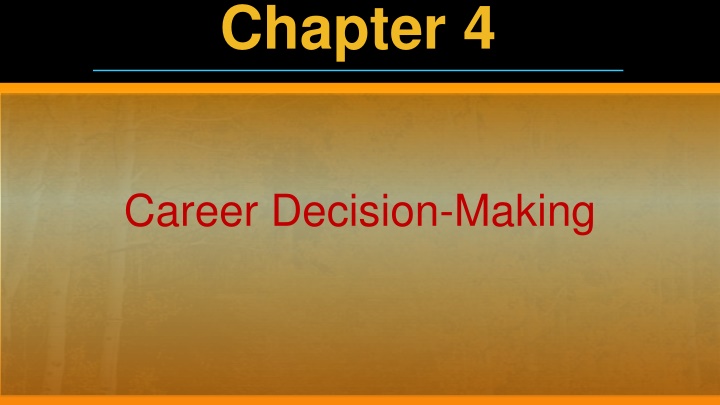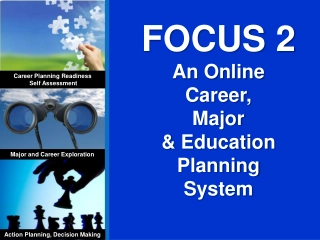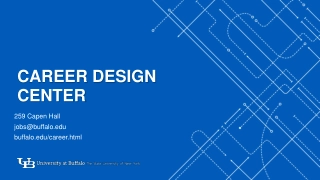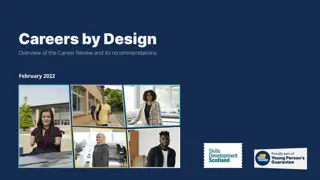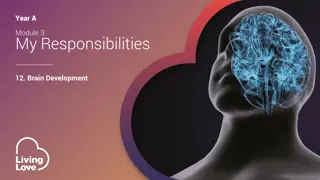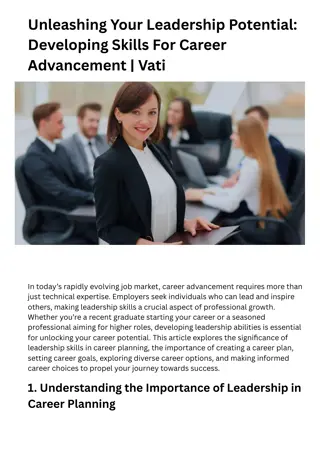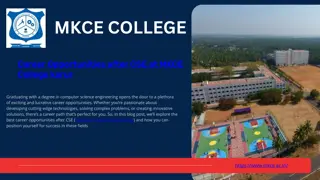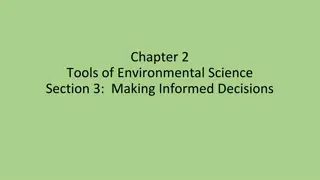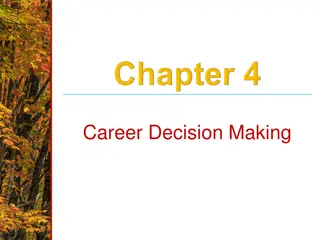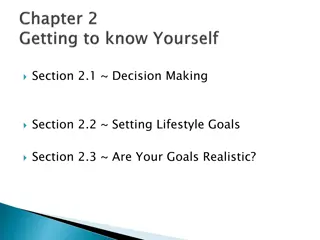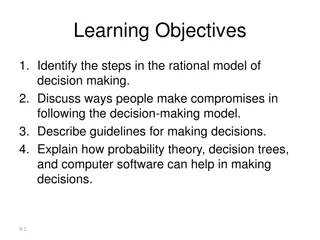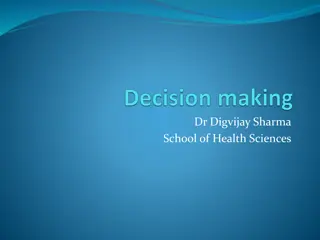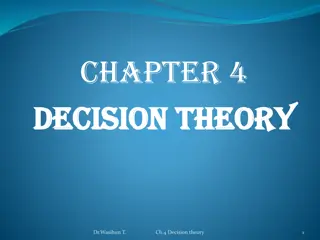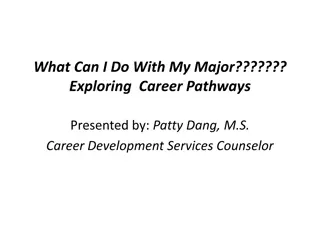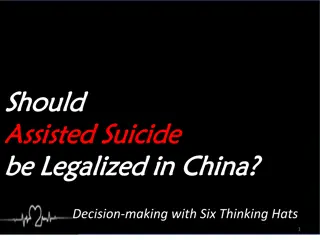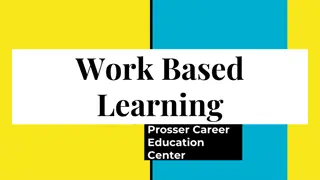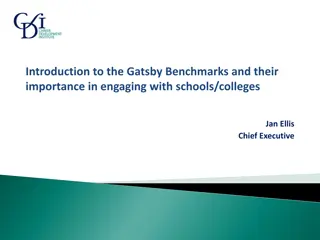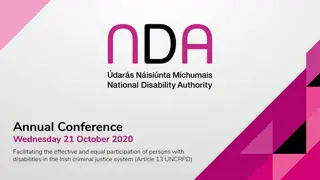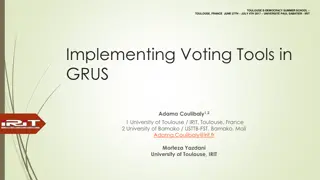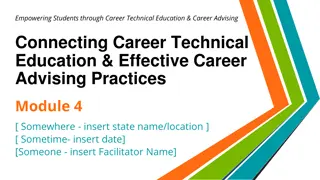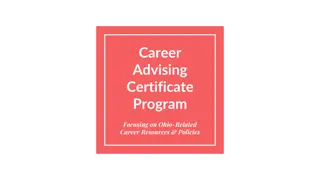Career Decision-Making Essentials
Key aspects of career decision-making including the importance, types of decision-makers, common problems, readiness factors, decision-making processes, and the CASVE cycle. Enhance your skills to make informed career choices effectively.
Uploaded on Feb 21, 2025 | 0 Views
Download Presentation

Please find below an Image/Link to download the presentation.
The content on the website is provided AS IS for your information and personal use only. It may not be sold, licensed, or shared on other websites without obtaining consent from the author.If you encounter any issues during the download, it is possible that the publisher has removed the file from their server.
You are allowed to download the files provided on this website for personal or commercial use, subject to the condition that they are used lawfully. All files are the property of their respective owners.
The content on the website is provided AS IS for your information and personal use only. It may not be sold, licensed, or shared on other websites without obtaining consent from the author.
E N D
Presentation Transcript
Chapter 4 Career Decision-Making
Pyramid of Information Processing DECISION SKILLS DOMAIN
Presentation Overview Importance of good decision-making Kinds of decision-makers Problems in effective decision-making Readiness for career decision-making CASVE cycle Improving decision-making skills
Importance of Decision-Making Indicator of our effectiveness in life Long-term implications of some decisions Others evaluate us by how we make decisions Process for making effective decisions can be learned
Kinds of Decision-Makers How do these How do these relate to the type relate to the type of career of career assistance assistance needed? needed? Decided Undecided Indecisive
Problems in Decision-Making Personal What are What are some examples some examples from each of from each of these areas? these areas? Family Society
Readiness for Career Decision-Making How might How might these these factors help or factors help or hinder career hinder career decision decision- - making? making? Capability Factors emotions, motivation, willingness to assume responsibility Complexity Factors family, social, economic, organizational conditions
Decision-Making Processes Recognizing a gap What are some gaps What are some gaps that college students that college students face related to career face related to career decision decision- -making? making? Analyzing its causes Coming up with ways to remove the gap Choosing an option to remove the gap Developing a strategy for implementing the choice Importance of a risk-taking attitude, ability to deal with happenstance!
CASVE Cycle Communication Execution Analysis Synthesis Valuing
Communication Becoming aware of the gap Discomfort becomes greater than fear of change Assistance sought when resources are inadequate
Communication Internal Conditions: 1)Emotions 2)Avoidance behavior 3)Physiological state
Communication External Conditions: 1)Event 2)Significant others
Analysis Clarify self-knowledge related to the gap Clarify option knowledge related to the gap Understanding how I make important decisions Understanding how my thinking influences choices
Analysis Clarify self-knowledge related to the gap What do I want? What have I learned from past experiences, e.g., family, tests, etc.? What are my values, interests, skills?
Analysis Clarify option knowledge What do I know about occupations, fields of study, or jobs? Do I have an effective schema for understanding the world of work?
Analysis Understanding how I make important decisions Willingness to accept responsibility Decision-making and learning styles Understanding how positive and negative thinking influences career choices
Synthesis What can I do to solve the gap? Goal: avoid missing alternatives while not becoming overwhelmed with options
Expanding & Narrowing My Options Synthesis Elaboration Brainstorming to expand list of possible options Synthesis Crystallization Reduce list to 3 5 options
Valuing Judging costs and benefits of each option to: 1)Oneself 2)Significant others, e.g., family 3)Cultural group 4)Community and/or society at large
Valuing Prioritizing options: First choice and back up choices What is the best choice for me? Significant others? Cultural group? Selecting a 1st option: Narrow gap identified in Communication phase
Execution Final phase converting thoughts into action Formulate goal and execute a plan for implementing your first choice Three activities: What are some What are some examples for examples for each of these each of these activities? activities? planning trying out applying
Communication Review external demands & internal states Has the gap been closed? Have negative emotions and physiological states improved? Am I taking action to achieve my goal?
Improving Career Decision-Making Decision-making is an ongoing process, not an event Process is a skill--can become almost automatic with continued practice and use Problems in one phase can shut down or derail entire problem-solving process Remember: career problems are continuous, you will likely repeat the cycle many times
Improving Decision-Making Skills Completing assessment instruments e.g., Career Thoughts Inventory (CTI) Use guides/worksheets Guide to Good Decision-Making, Appendix F Observe other successful decision makers Conduct information interviews, read biographies Reflect on where you are in the CASVE cycle Communication Analysis Execution Valuing Synthesis
